check engine KIA Rio 2005 2.G User Guide
[x] Cancel search | Manufacturer: KIA, Model Year: 2005, Model line: Rio, Model: KIA Rio 2005 2.GPages: 238, PDF Size: 2.6 MB
Page 111 of 238

Driving Your Vehicle4-30Continuously ON :
If the CHECK ENGINE light comes ON while driving
and illuminates continuously, a potential problem has
been discovered in the ECS or one of the exhaust sys-
tem components. Generally, the vehicle will continue
to be driveable but it should be checked by an autho-
rized Kia dealer as soon as possible. This condition is
unlikely to lead to engine damage unless a decrease in
vehicle power or poor running conditions is immedi-
ately apparent.
Malfunction Indicator The CHECK ENGINE or malfunction indicator light is
installed in your vehicle's instrument panel and
responds to signals from the vehicle's On Board
Diagnostic (OBD -II) System. The OBD-II System
monitors the performance of the vehicle's Emission
Control System (ECS), which is designed to reduce the
amount of air pollutants in engine exhaust to the levels
required by government regulations.
When you first start the engine, the CHECK ENGINE
light will illuminate briefly as a system check to con-
firm that the OBD-II System is operating properly. As
the engine starts, this light turns off. However, if at
any time the OBD-II system detects a faulty signal or
determines that the ECS is not performing to specifica-
tion, the CHECK ENGINE light will illuminate contin-
uously or flash.
CHECK
RIO ENG CNA 4.qxd 7/29/05 5:06 PM Page 30
Page 112 of 238
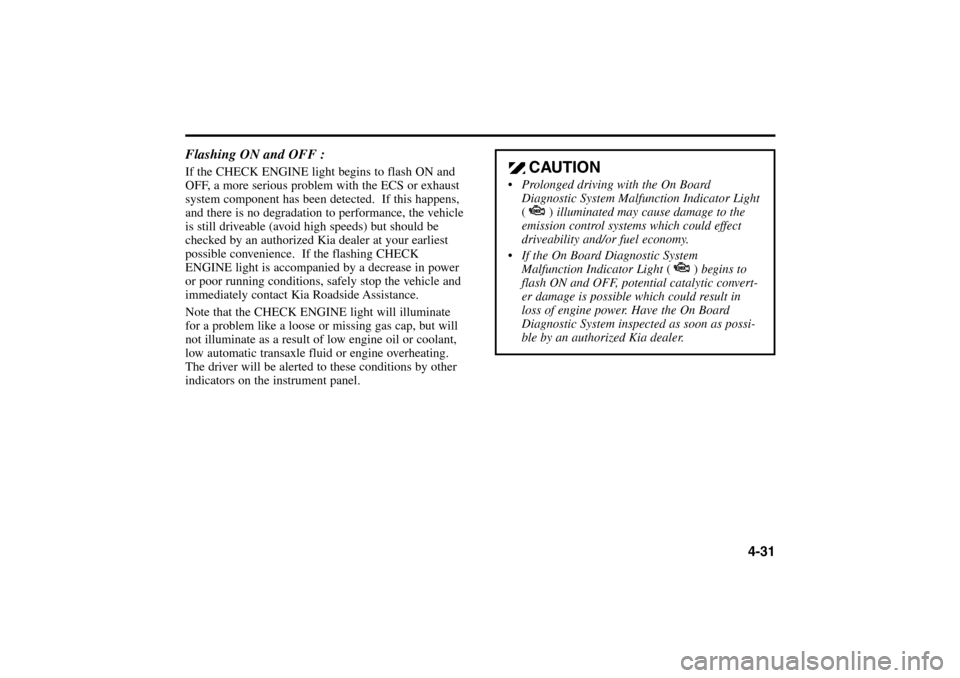
4-31 Flashing ON and OFF :
If the CHECK ENGINE light begins to flash ON and
OFF, a more serious problem with the ECS or exhaust
system component has been detected. If this happens,
and there is no degradation to performance, the vehicle
is still driveable (avoid high speeds) but should be
checked by an authorized Kia dealer at your earliest
possible convenience. If the flashing CHECK
ENGINE light is accompanied by a decrease in power
or poor running conditions, safely stop the vehicle and
immediately contact Kia Roadside Assistance.
Note that the CHECK ENGINE light will illuminate
for a problem like a loose or missing gas cap, but will
not illuminate as a result of low engine oil or coolant,
low automatic transaxle fluid or engine overheating.
The driver will be alerted to these conditions by other
indicators on the instrument panel.
CAUTION
Prolonged driving with the On Board
Diagnostic System Malfunction Indicator Light
()illuminated may cause damage to the
emission control systems which could effect
driveability and/or fuel economy.
If the On Board Diagnostic System
Malfunction Indicator Light () begins to
flash ON and OFF, potential catalytic convert-
er damage is possible which could result in
loss of engine power. Have the On Board
Diagnostic System inspected as soon as possi-
ble by an authorized Kia dealer.
CHECK
CHECK
CHECK
CHECK
RIO ENG CNA 4.qxd 7/29/05 5:06 PM Page 31
Page 114 of 238

4-33 Door Ajar Warning
This warning light comes on when a door is not closed
securely with the ignition switch in any position.Anti-Lock Brake System (ABS)
Warning Light (if equipped)This light illuminates when you start the engine. The
light will go off if the ABS system is operating nor-
mally. Also, this light comes on if the key is turned to
ON, and then goes off in 2-3 seconds if the system is
operating normally.
If this warning light illuminates while the vehicle is
being driven, have the vehicle checked by an autho-
rized Kia Dealer as soon as possible.Rear Window Defroster Indicator This light comes on when the rear defroster is ON.Rear Hatch Warning Light
(5 door-if equipped)This warning light comes on when a rear hatch is not
closed securely with the ignition switch in any posi-
tion.
AS2B04020
LightingLighting ControlTo turn the lights on, twist the knob on the end of the
control lever which is located on the steering column
to the left of the steering wheel.
First position
Tail, parking, license and sidemarker lights and instru-
ment panel lights ON.
Second position
Head, tail, parking, license and sidemarker lights and
instrument panel lights ON.
ABS
RIO ENG CNA 4.qxd 7/29/05 5:06 PM Page 33
Page 118 of 238
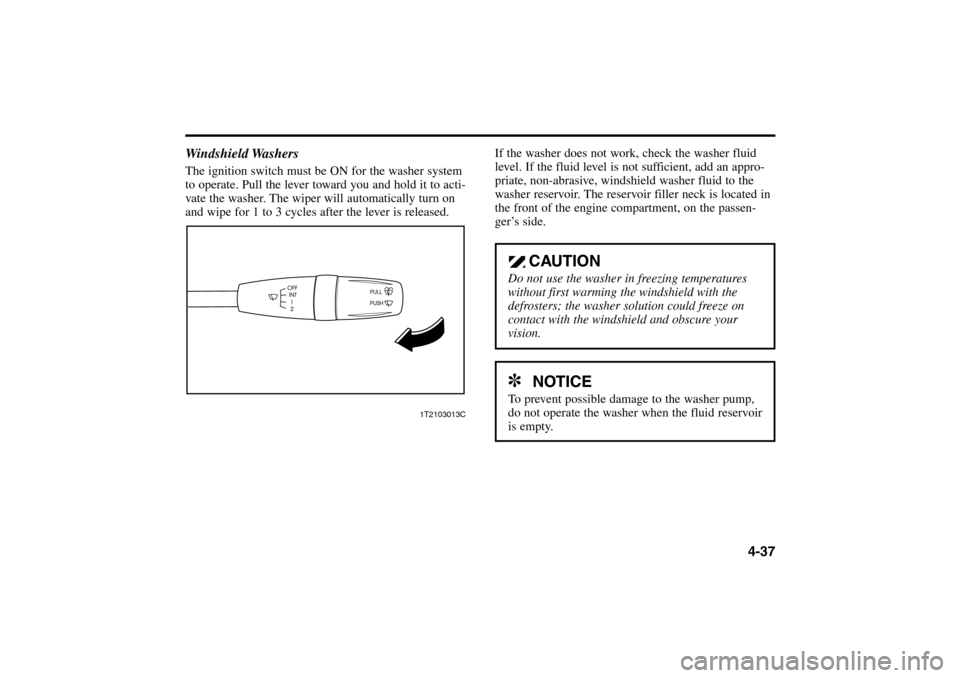
4-37 Windshield Washers
The ignition switch must be ON for the washer system
to operate. Pull the lever toward you and hold it to acti-
vate the washer. The wiper will automatically turn on
and wipe for 1 to 3 cycles after the lever is released.
1T2103013C
If the washer does not work, check the washer fluid
level. If the fluid level is not sufficient, add an appro-
priate, non-abrasive, windshield washer fluid to the
washer reservoir. The reservoir filler neck is located in
the front of the engine compartment, on the passen-
ger’s side.
CAUTION
Do not use the washer in freezing temperatures
without first warming the windshield with the
defrosters; the washer solution could freeze on
contact with the windshield and obscure your
vision.✽
NOTICE
To prevent possible damage to the washer pump,
do not operate the washer when the fluid reservoir
is empty.
RIO ENG CNA 4.qxd 7/29/05 5:06 PM Page 37
Page 137 of 238
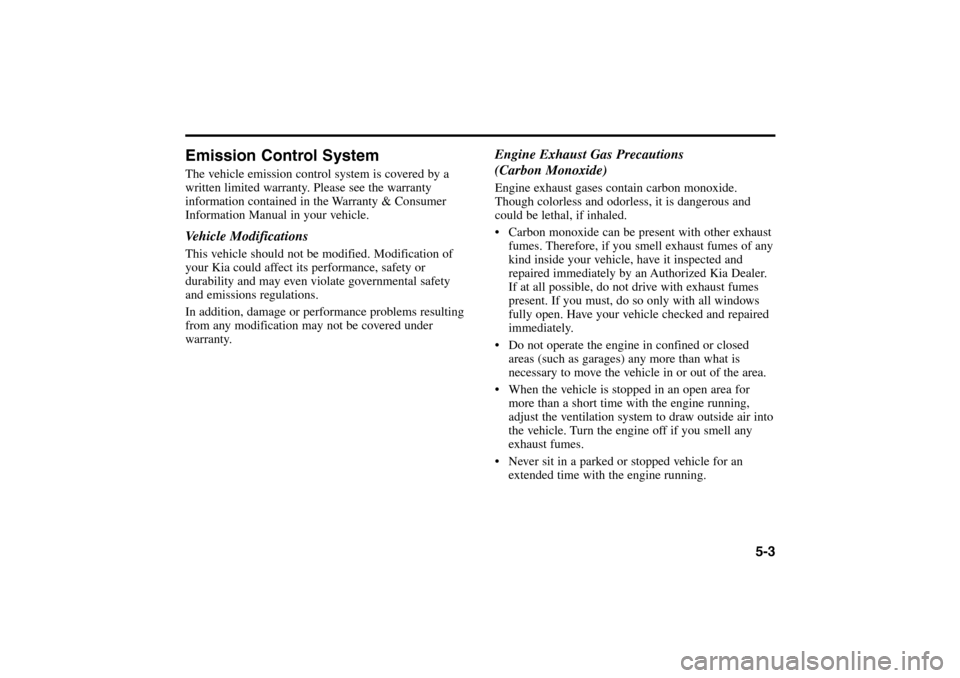
Emission Control SystemThe vehicle emission control system is covered by a
written limited warranty. Please see the warranty
information contained in the Warranty & Consumer
Information Manual in your vehicle.Vehicle ModificationsThis vehicle should not be modified. Modification of
your Kia could affect its performance, safety or
durability and may even violate governmental safety
and emissions regulations.
In addition, damage or performance problems resulting
from any modification may not be covered under
warranty.
Engine Exhaust Gas Precautions
(Carbon Monoxide)Engine exhaust gases contain carbon monoxide.
Though colorless and odorless, it is dangerous and
could be lethal, if inhaled.
Carbon monoxide can be present with other exhaust
fumes. Therefore, if you smell exhaust fumes of any
kind inside your vehicle, have it inspected and
repaired immediately by an Authorized Kia Dealer.
If at all possible, do not drive with exhaust fumes
present. If you must, do so only with all windows
fully open. Have your vehicle checked and repaired
immediately.
Do not operate the engine in confined or closed
areas (such as garages) any more than what is
necessary to move the vehicle in or out of the area.
When the vehicle is stopped in an open area for
more than a short time with the engine running,
adjust the ventilation system to draw outside air into
the vehicle. Turn the engine off if you smell any
exhaust fumes.
Never sit in a parked or stopped vehicle for an
extended time with the engine running.
5-3
RIO ENG CNA 5.qxd 7/29/05 5:07 PM Page 3
Page 138 of 238

Operating Precautions for Catalytic ConvertersYour vehicle is equipped with a catalytic converter
emission control device.
Therefore, the following precautions must be observed:
Use only UNLEADED FUEL.
Do not park the vehicle over or near flammable
objects, such as dry grass, paper, leaves, etc. Under
certain conditions, they could be ignited by a hot
exhaust system.
Do not operate the vehicle when there are signs of
engine malfunction, such as misfire or a noticeable
loss of performance.
Do not misuse or abuse the engine. Examples of
misuse are coasting with the ignition off and
descending steep grades in gear with the ignition
off.
Do not operate the engine at high idle speed for
extended periods (5 minutes or more). Do not modify or tamper with any part of the engine
or emission control system. All inspections and
adjustments must be made by a qualified technician.
Failure to observe the above precautions could result in
damage to the catalytic converter and to your vehicle
and could void your warranties.
Before DrivingBefore entering vehicle:
Be sure that all windows, outside mirror(s), and
outside lights are clean.
Check the condition of the tires.
Check under the vehicle for any sign of leaks.
Be sure there are no obstacles behind you if you
intend to back up.
Driving Tips5-4
RIO ENG CNA 5.qxd 7/29/05 5:07 PM Page 4
Page 139 of 238
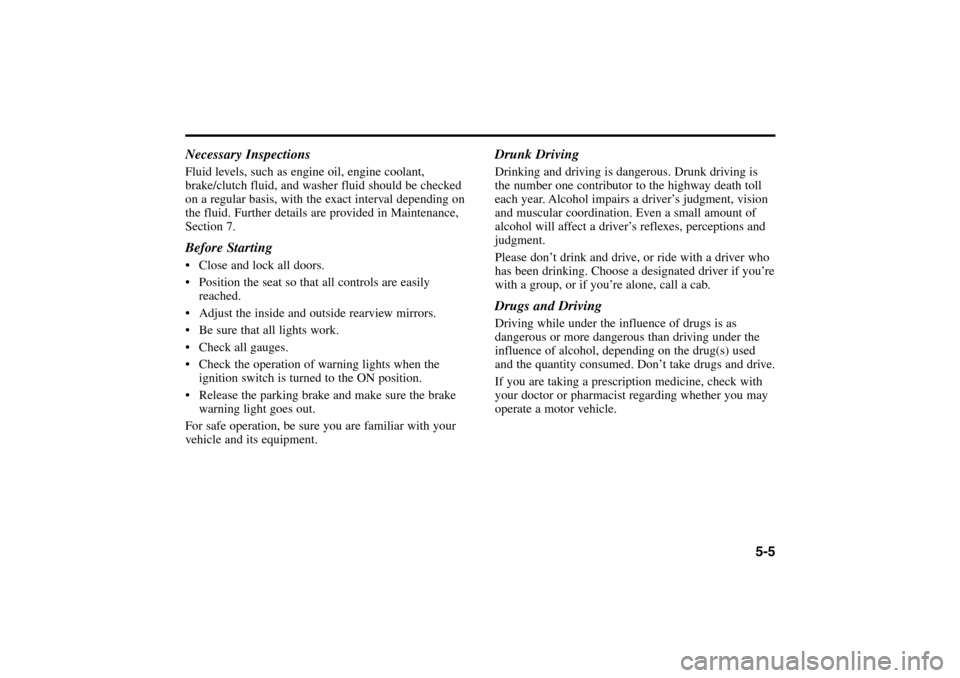
Necessary InspectionsFluid levels, such as engine oil, engine coolant,
brake/clutch fluid, and washer fluid should be checked
on a regular basis, with the exact interval depending on
the fluid. Further details are provided in Maintenance,
Section 7.Before Starting Close and lock all doors.
Position the seat so that all controls are easily
reached.
Adjust the inside and outside rearview mirrors.
Be sure that all lights work.
Check all gauges.
Check the operation of warning lights when the
ignition switch is turned to the ON position.
Release the parking brake and make sure the brake
warning light goes out.
For safe operation, be sure you are familiar with your
vehicle and its equipment.
Drunk DrivingDrinking and driving is dangerous. Drunk driving is
the number one contributor to the highway death toll
each year. Alcohol impairs a driver’s judgment, vision
and muscular coordination. Even a small amount of
alcohol will affect a driver’s reflexes, perceptions and
judgment.
Please don’t drink and drive, or ride with a driver who
has been drinking. Choose a designated driver if you’re
with a group, or if you’re alone, call a cab.Drugs and DrivingDriving while under the influence of drugs is as
dangerous or more dangerous than driving under the
influence of alcohol, depending on the drug(s) used
and the quantity consumed. Don’t take drugs and drive.
If you are taking a prescription medicine, check with
your doctor or pharmacist regarding whether you may
operate a motor vehicle.
5-5
RIO ENG CNA 5.qxd 7/29/05 5:07 PM Page 5
Page 144 of 238
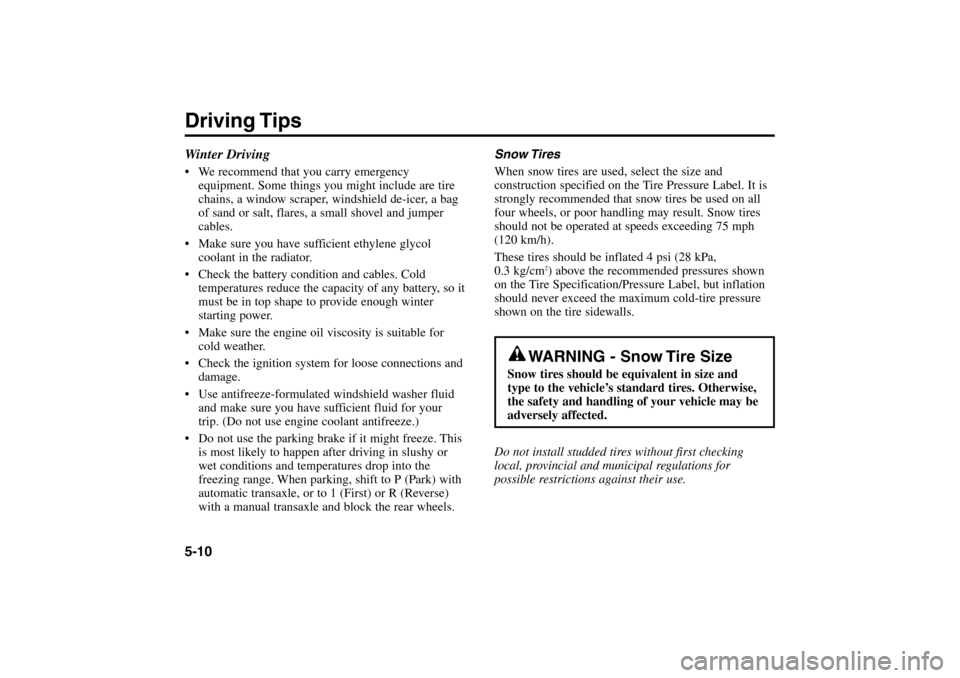
Driving Tips5-10
Snow Tires
When snow tires are used, select the size and
construction specified on the Tire Pressure Label. It is
strongly recommended that snow tires be used on all
four wheels, or poor handling may result. Snow tires
should not be operated at speeds exceeding 75 mph
(120 km/h).
These tires should be inflated 4 psi (28 kPa,
0.3 kg/cm
2) above the recommended pressures shown
on the Tire Specification/Pressure Label, but inflation
should never exceed the maximum cold-tire pressure
shown on the tire sidewalls.
Do not install studded tires without first checking
local, provincial and municipal regulations for
possible restrictions against their use.
WARNING - Snow Tire Size
Snow tires should be equivalent in size and
type to the vehicle’s standard tires. Otherwise,
the safety and handling of your vehicle may be
adversely affected.
Winter Driving We recommend that you carry emergency
equipment. Some things you might include are tire
chains, a window scraper, windshield de-icer, a bag
of sand or salt, flares, a small shovel and jumper
cables.
Make sure you have sufficient ethylene glycol
coolant in the radiator.
Check the battery condition and cables. Cold
temperatures reduce the capacity of any battery, so it
must be in top shape to provide enough winter
starting power.
Make sure the engine oil viscosity is suitable for
cold weather.
Check the ignition system for loose connections and
damage.
Use antifreeze-formulated windshield washer fluid
and make sure you have sufficient fluid for your
trip. (Do not use engine coolant antifreeze.)
Do not use the parking brake if it might freeze. This
is most likely to happen after driving in slushy or
wet conditions and temperatures drop into the
freezing range. When parking, shift to P (Park) with
automatic transaxle, or to 1 (First) or R (Reverse)
with a manual transaxle and block the rear wheels.
RIO ENG CNA 5.qxd 7/29/05 5:07 PM Page 10
Page 152 of 238
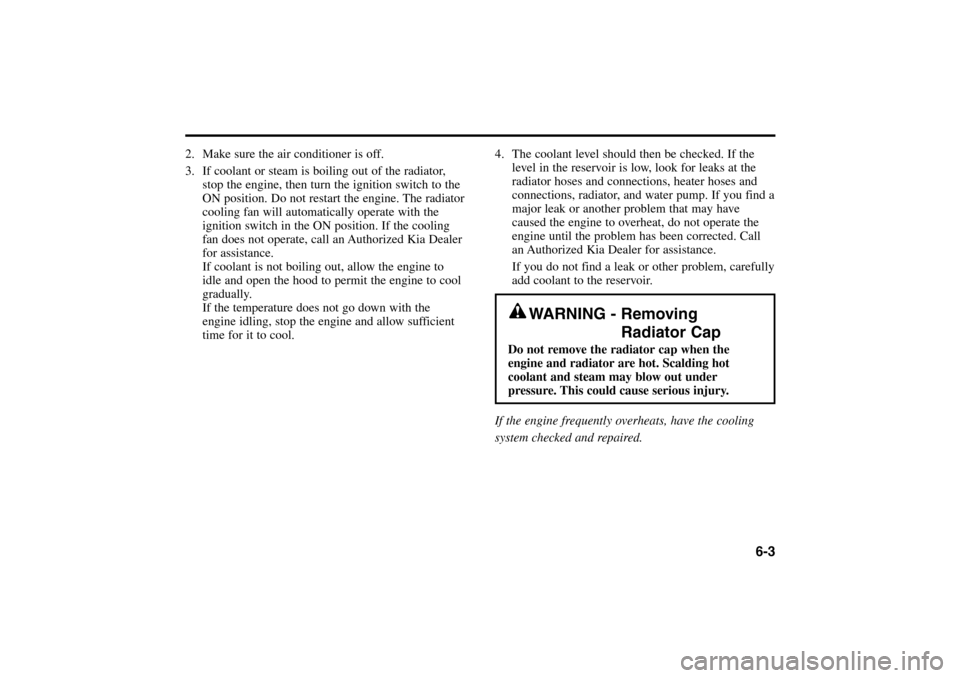
2. Make sure the air conditioner is off.
3. If coolant or steam is boiling out of the radiator,
stop the engine, then turn the ignition switch to the
ON position. Do not restart the engine. The radiator
cooling fan will automatically operate with the
ignition switch in the ON position. If the cooling
fan does not operate, call an Authorized Kia Dealer
for assistance.
If coolant is not boiling out, allow the engine to
idle and open the hood to permit the engine to cool
gradually.
If the temperature does not go down with the
engine idling, stop the engine and allow sufficient
time for it to cool.4. The coolant level should then be checked. If the
level in the reservoir is low, look for leaks at the
radiator hoses and connections, heater hoses and
connections, radiator, and water pump. If you find a
major leak or another problem that may have
caused the engine to overheat, do not operate the
engine until the problem has been corrected. Call
an Authorized Kia Dealer for assistance.
If you do not find a leak or other problem, carefully
add coolant to the reservoir.
If the engine frequently overheats, have the cooling
system checked and repaired.
6-3
WARNING - Removing
Radiator Cap
Do not remove the radiator cap when the
engine and radiator are hot. Scalding hot
coolant and steam may blow out under
pressure. This could cause serious injury.
RIO ENG CNA 6.qxd 7/29/05 5:15 PM Page 3
Page 155 of 238

4. Turn off all unnecessary electrical loads.
5. Connect the jumper cables in the exact sequence
shown in the illustration on the previous page.
First, connect one end of a jumper cable to the
positive terminal (+) of the discharged battery ,
then the other end of the same cable to the positive
terminal (+) on the booster battery . Next,
connect one end of the other jumper cable to the
negative terminal (–) of the booster battery , then
the other end to a solid, stationary, metallic point
(for example, the engine lifting bracket) away
from the battery. Do not connect the jumper cable
to or near any part that moves when the engine is
cranked. Do not connect the jumper cable from the
negative terminal (–) of the booster battery to the
negative terminal (–) of the discharged battery. Do
not allow the jumper cables to contact anything
except the correct battery terminals or the correct
ground. Do not lean over the battery when making
connections.6. Start the engine of the vehicle with the booster
battery and run it at 2,000 rpm. Then, start the
engine of the vehicle with the discharged battery.
If the cause of your battery discharging is not apparent
(for example, having left the lights on accidentally),
you should have your vehicle checked by an Authorized
Kia Dealer.
Push-StartingA vehicle equipped with an automatic transaxle cannot
be started by pushing. A vehicle equipped with a
manual transaxle should not be push-started because it
could damage the emission control system. Follow the
directions for jump starting.
In Case Of An Emergency6-6
CAUTION
Never tow a vehicle to start it. A sudden surge
forward when the engine starts could cause a
collision with the tow vehicle.
1
2
3
4
RIO ENG CNA 6.qxd 7/29/05 5:15 PM Page 6